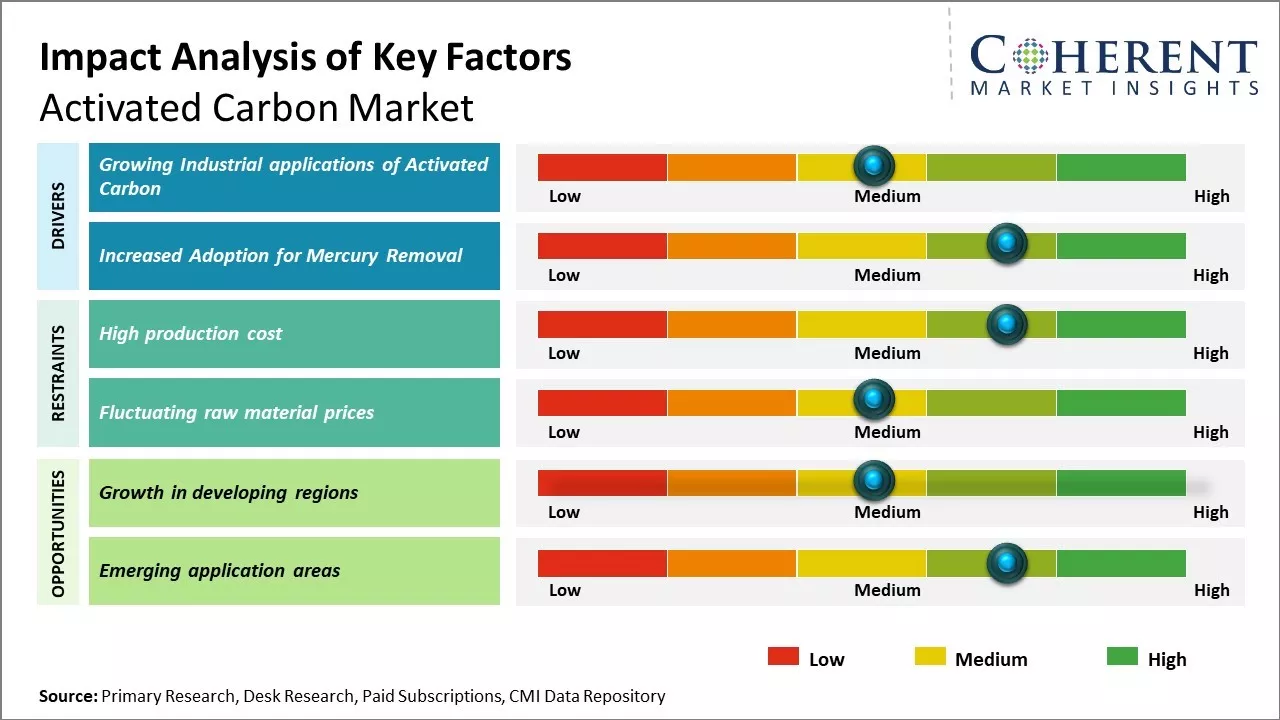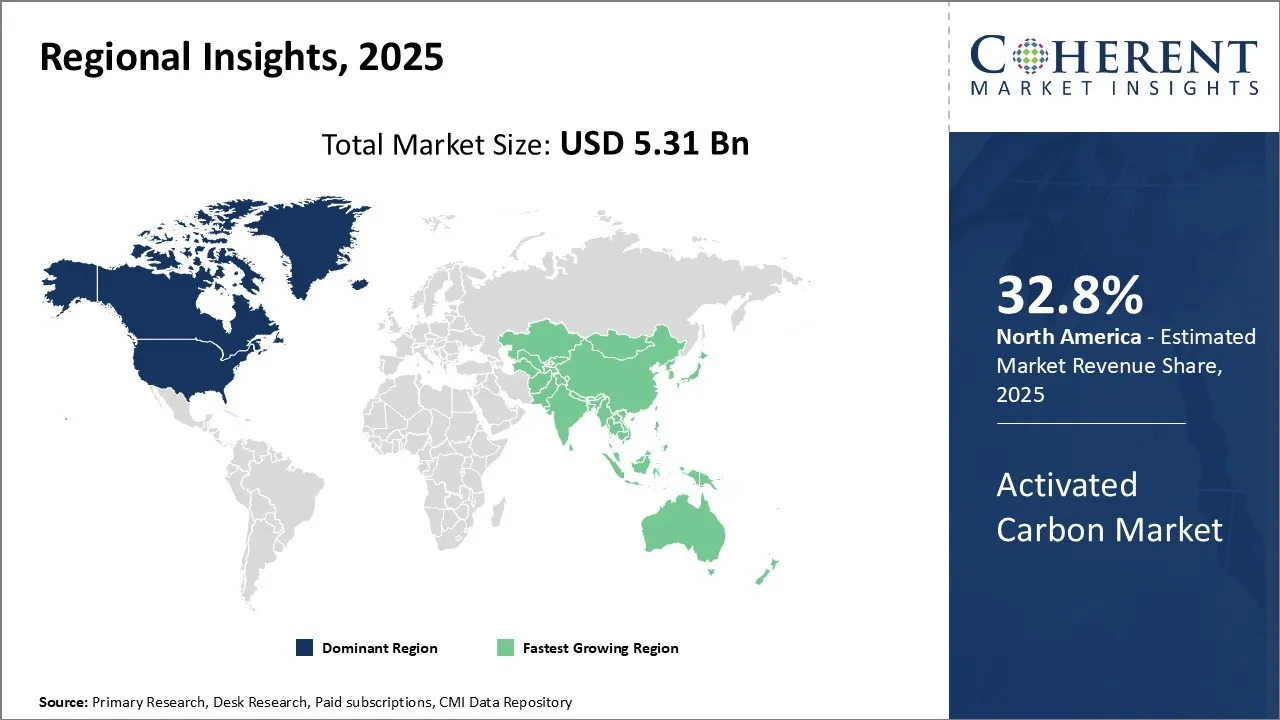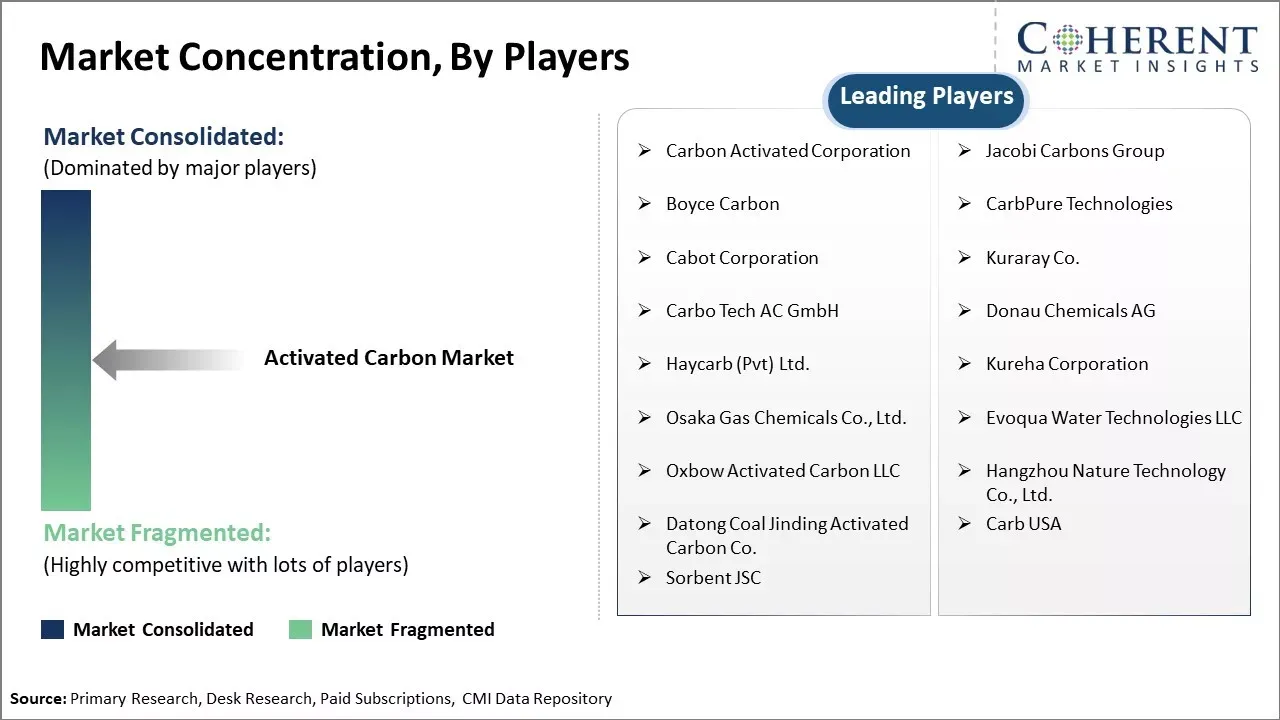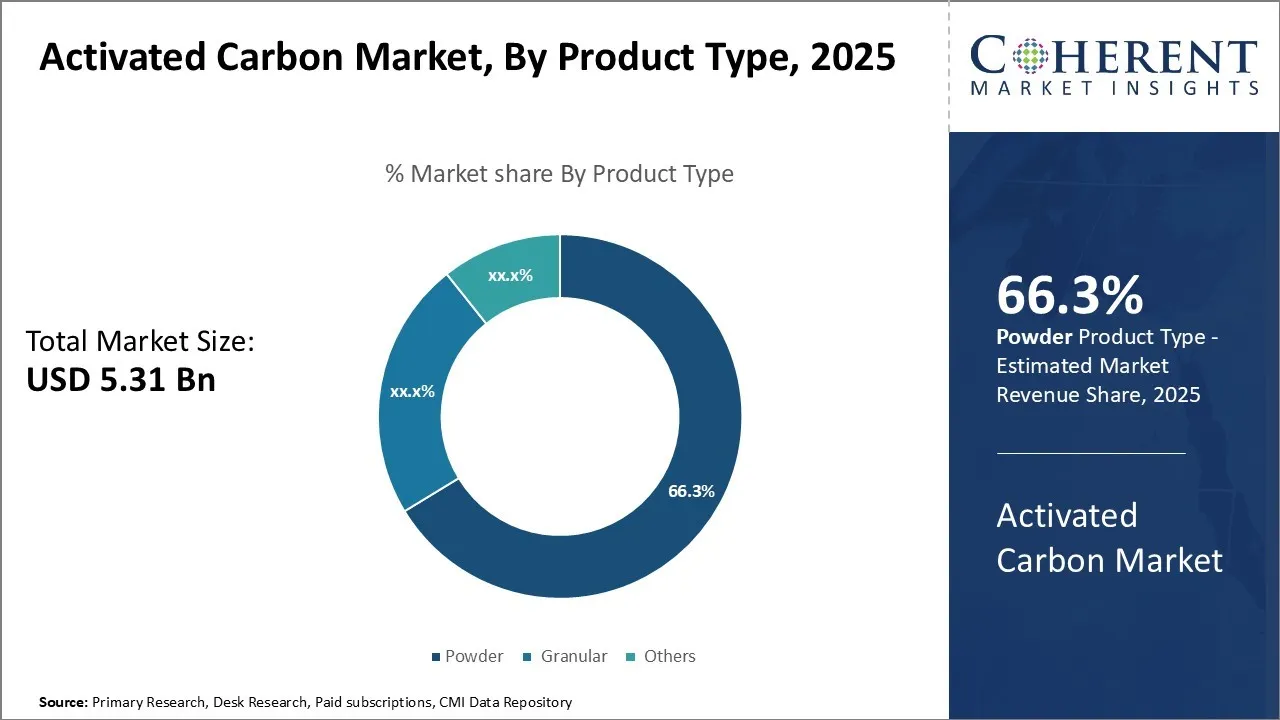Activated Carbon Market Size and Trends - 2025 to 2032
The activated carbon market is estimated to be valued at USD 5.31 Bn in 2025 and is expected to reach USD 10.29 Bn by 2032, exhibiting a compound annual growth rate (CAGR) of 9.9% from 2025 to 2032.
Key Takeaways
- Based on Product Type, the Powder segment is expected to lead the market with 66.3% share of the market in 2025, driven by its fast, efficient adsorption.
- Based on Material Type, the Coal-Based segment is expected to hold 30.3% share of the market in 2025, driven by its low cost and mature production process.
- Based on End-User, the water Treatment segment is projected to account for 30.6% share of the market in 2025, driven by stricter regulations and clean water demand.
- Based on Region, North America is set to lead the activated carbon market with 32.8% share in 2025. While, Asia Pacific is anticipated to be the fastest growing region.

To learn more about this report, Download Free Sample
Market Overview
The activated carbon market is expected to witness significant growth over the coming years. There is an increasing demand for activated carbon across various end-use industries such as water treatment, food & beverage, pharmaceutical, and others. The growing environmental concerns and stringent regulations regarding water & wastewater treatment across various countries are encouraging the growth of the activated carbon market. Furthermore, rising industrialization and urbanization in developing nations are also driving the activated carbon market growth.
Current Event and its Impacts on the Activated Carbon Market
|
Current Event |
Description and its Impact |
|
Strengthening Global Environmental Regulations and Net-Zero Commitments |
|
|
Emerging Contaminants and Public Health Concerns |
|
Uncover macros and micros vetted on 75+ parameters: Get instant access to report
Technology & Innovation
- Reactivated Carbon
- Growing adoption reduces costs and supports sustainability.
- Reactivation plants (e.g., Kemira in Sweden) extend carbon life cycles.
- Nanotechnology Integration
- Development of nano-activated carbon for higher adsorption efficiency.
- Applications in pharmaceutical residue removal and advanced air filters.
- Bio-Based Carbon
- Emerging production from coconut shells, wood, and agro-waste.
- Lower carbon footprint compared to coal-based activated carbon.
Activated Carbon Market Insights By Product Type: Powder Segment Drives Product Type Growth
In terms of product type, powder is expected to contribute 66.3% share of the market in 2025, owing to its widespread applications and adaptability. Powdered activated carbon is highly porous and adsorbent in nature, enabling it to effectively trap and remove a variety of impurities and contaminants from liquid and gas streams. Its fine particulate structure allows it to fully saturate matrices and absorb toxins more comprehensively than granular forms. Powder is commonly used in water treatment facilities to purify municipal water supplies and remove unwanted odors, tastes and toxins left over from disinfection processes. It helps plants meet stringent regulatory drinking water standards in a cost-efficient manner. Due to its small particle size, powder also demonstrates fast adsorption kinetics, quickly filtering out dissolved compounds.
Activated Carbon Market Insights By Raw material type: Coal Segment Dominates Raw Material Type
In terms of raw material type, coal is expected to contribute 30.3% share of the market in 2025, owing to its widespread availability, low cost and well-established production process. Coal-based activated carbon has been popular for many decades due its affinity for adsorbing various toxins, odorous molecules, and impurities. Its production involves the utilization of coal's organic carbon content and high carbon yields through controlled gasification and pyrolysis. This thermochemical activation methodology is a mature technology resulting in a consistent, predictable final product.
Activated Carbon Market Insights By End User: Water Treatment Boosts the End-user Growth
In terms of end-user, water treatment is expected to contributes 30.6% share of the market in 2025, owing to stricter environmental regulations and the growing need for potable water worldwide. Activated carbon finds widespread application in municipal and industrial water purification plants to remove toxic compounds, excessive organic matter, dissolved solids and particulates that conventional filtration cannot eliminate. It helps augment the effectiveness of existing treatment trains and bridge technology gaps - critical for delivering clean water in compliance with global quality standards.
For instance, in April 2025, Ozone Strong Water assists Dutch water companies NieuWater, Nijhuis Saur Industries, and Jotem grow BODAC around the world. The Biological Oxygen Dosed Activated Carbon technology has been around for 15 years and is known to remove up to 90% of micropollutants, cut chemical use by 90%, extend the life of RO membranes, and lower treatment costs.
Regional Insights

To learn more about this report, Download Free Sample
North America Activated Carbon Market Analysis & Trends
North America has established itself as the most dominant region in the global activated carbon market. The region accounts for over 32.8% of the worldwide demand in 2025, owing to a strong presence of major end-use industries such as water treatment and air purification in the U.S. and Canada. Stringent environmental regulations regarding water treatment along with mature industrial sector have propelled the product consumption in this region over the years. Strong industrial base of water treatment plants, pharmaceutical, and food & beverage industries rely on activated carbon for purification and processing applications.
For instance, in December 2025, Calgon Carbon, which is based in Pittsburgh, Pennsylvania, announced that it had been given new U.S. patents for advanced activated carbon sorbents. The new product strengthens its range of water and air purification technologies, which are aimed at meeting stricter environmental rules. These engineered sorbents make it easier to get rid of pollutants, which strengthens Calgon Carbon's position as the leader in global activated carbon solutions.
Asia Pacific Activated Carbon Market Analysis & Trends
The activated carbon market in the Asia Pacific region has emerged as the fastest growing market globally. China dominates the Asia Pacific activated carbon market both in terms of production as well as consumption. Rapid industrialization and strict environmental policies have fueled the product demand from industries such as water treatment, air purification and food & beverages in China. Expanding middle-class population and developing economy of other Asian countries like India is also driving the growth. Developing regions in Asia Pacific offer lucrative growth opportunities to both international as well as domestic activated carbon companies with their huge industrial development plans.
For instance, in September 2025, The Asia Pacific Technical Center of Kuraray Co., Ltd. is now open in Singapore Science Park. The facility will offer advanced technical help for EVAL™ EVOH resin, PVOH resin, and activated carbon. The center has material evaluation labs that help Kuraray come up with new ideas and work with customers in the growing Asian market.
Activated Carbon Market Outlook Country-Wise
The U.S. Activated Carbon Market Trends
The U.S. activated carbon market in 2025 is anticipated to be driven by stricter environmental rules and a growing need to clean up water, control air quality, and get rid of PFAS. Usage goes up as the pharmaceutical, food and beverage, and industrial sectors grow. Sustainability goals and advanced sorbent technologies make it even more likely that people are going to utilize them in a variety of ways.
For instance, in August 2025, ARQ has set up its first granular activated carbon production line at the Red River Plant in Colorado. The company, which is based in Greenwood Village, has reached a major milestone by making its first sales. It plans to increase production to 25 million pounds per year, which is going to make it a stronger player in the field of environmental purification solutions.
China Activated Carbon Market Trends
The market for activated carbon in China in 2025 is expected to be driven by stricter environmental rules and a growing need for industrial filtration, air purification, and water treatment. Usage goes up as the chemical, petrochemical, and beverage industries grow. China is the world leader in activated carbon innovation considering it has programs that promote sustainability and bio-based carbons made from agricultural waste.
For instance, in August 2025, The Nanping Yuanli Active Carbon Company from China and the Carbonitalia S.r.l. from Italy have started a strategic joint venture to improve the production of sustainable activated carbon. The Euro-Chinese alliance wants to change the rules of the game in the industry, make global supply chains more expansive, and send the next generation of sorbents around the world for use in cleaning up water, air, and industrial processes.
Market Report Scope
Activated Carbon Market Report Coverage
| Report Coverage | Details | ||
|---|---|---|---|
| Base Year: | 2024 | Market Size in 2025: | USD 5.31 Bn |
| Historical Data for: | 2020 To 2024 | Forecast Period: | 2025 To 2032 |
| Forecast Period 2025 to 2032 CAGR: | 9.9% | 2032 Value Projection: | USD 10.29 Bn |
| Geographies covered: |
|
||
| Segments covered: |
|
||
| Companies covered: |
Carbon Activated Corporation, Jacobi Carbons Group, Boyce Carbon, CarbPure Technologies, Cabot Corporation, Kuraray Co., Carbo Tech AC GmbH, Donau Chemicals AG, Haycarb (Pvt) Ltd., Kureha Corporation, Osaka Gas Chemicals Co., Ltd., Evoqua Water Technologies LLC, Oxbow Activated Carbon LLC, Hangzhou Nature Technology Co., Ltd., Datong Coal Jinding Activated Carbon Co., Carb USA, and Sorbent JSC |
||
| Growth Drivers: |
|
||
| Restraints & Challenges: |
|
||
Uncover macros and micros vetted on 75+ parameters: Get instant access to report
Activated Carbon Market Driver
Growing Industrial Applications of Activated Carbon
The use of activated carbon is growing across different industrial verticals owing to its excellent adsorption properties. Industries such as water treatment, food & beverage, and pharmaceuticals have been major consumers of activated carbon. The water treatment industry in particular has seen substantial growth in demand for activated carbon due to the increasing need for purification of water sources across municipal as well as industrial applications. Stringent regulations regarding the removal of pollutants, disinfection byproducts and purification of drinking water have propelled the use of activated carbon in water treatment plants. Its effectiveness in removing color, odor, taste and a variety of organic and inorganic impurities from water makes it the preferred choice for adsorption applications over other alternatives. With growing global population and rising industrial activities, the stress on water resources is continuously increasing. This has bolstered investments towards upgrading existing as well as building new water treatment facilities which utilize activated carbon on a large scale.
Another sector driving significant activated carbon consumption is food & beverage industry. Major functionalities driving its use include purification of process water, finished product water as well as air purification applications across bottling, brewing and other beverage producers. Stringent international quality standards regarding the presence of contaminants in packaged foods and beverages have amplified the role of activated carbon in purification processes. Moreover, activated carbon is also gaining prominence as an effective strategy for color and odor removal in fruit juices, sugar processing and recovery of valuable flavor and fragrance compounds from the food processing industry. Growing health-conscious consumer trends promoting minimally processed and natural foods without the use of artificial preservatives are working in favor of activated carbon adoption. With sustained growth anticipated across food and beverage manufacturing globally in the coming years on the back of rising incomes, changing diets and urbanization - the demand for activated carbon from this sector is expected to see further acceleration.
Increased Adoption for Mercury Removal
Activated carbon has emerged as the material of choice for controlling and removing mercury emissions from coal-fired power plants. Stringent environmental regulations imposed by governments worldwide are pressurizing power generators to curb toxic mercury pollution emanating from burning of coal.
Activated Carbon Market Opportunities
Growth in developing regions
Growth in developing regions presents a significant opportunity for the global activated carbon market. Countries in Asia Pacific, South America, Middle East and Africa are witnessing rapid industrialization and infrastructure development. With improving economic conditions, consumption of processed food and beverages is also rising sharply in these regions. Stringent food safety regulations and increasing health consciousness have further boosted the demand for activated carbon as a key processing additive and purification agent.
Market Concentration and Competitive Landscape

To learn more about this report, Download Free Sample
Activated Carbon Industry News
- In September 2025, Kemira's Helsingborg site in Sweden has been given permission to go ahead for its activated carbon reactivation plant. This is an important advance toward sustainability. The facility cleans up used carbon so it can be used again. This reduces waste and helps customers who need to treat water. The announcement comes at the same time as the site's 150th anniversary, which honors a long history of coming up with new chemicals and ways to help the environment.
- In May 14, 2024, Organic Recycling Systems Limited, a leading provider of sustainable waste management solutions, announced the launch of its Alpha Carbon special platform for the activated carbon market
- In May 2024, Indcarb Activated Carbon, a leading manufacturer of high-quality activated carbon products, announced the launch of its new inline water filters featuring coconut shell-based activated carbon materials
- In March 2023, Evoqua Water Technologies LLC, a leading provider of water and wastewater treatment solutions, completed the acquisition of Bob Johnson & Associates, a Texas-based industrial water standard treatment service business. This strategic move was made to strengthen Evoqua's presence in North America.
Market Segmentation
- Product Type Insights (Revenue, USD Bn, 2025 - 2032)
- Powder
- Granular
- Others
- Raw Material Type Insights (Revenue, USD Bn, 2025 - 2032)
- Coal
- Coconut
- Wood
- Others
- End-user Insights (Revenue, USD Bn, 2025 - 2032)
- Water Treatment
- Food & Beverage Processing
- Pharmaceutical & Medical
- Automotive
- Air Purification
- Others
- Regional Insights (Revenue, USD Bn, 2025 - 2032)
- North America
- U.S.
- Canada
- Latin America
- Brazil
- Argentina
- Mexico
- Rest of Latin America
- Europe
- Germany
- U.K.
- Spain
- France
- Italy
- Russia
- Rest of Europe
- Asia Pacific
- China
- India
- Japan
- Australia
- South Korea
- ASEAN
- Rest of Asia Pacific
- Middle East & Africa
- GCC Countries
- Israel
- Rest of Middle East & Africa
- Key Players Insights
- Carbon Activated Corporation
- Jacobi Carbons Group
- Boyce Carbon
- CarbPure Technologies
- Cabot Corporation
- Kuraray Co.
- Carbo Tech AC GmbH
- Donau Chemicals AG
- Haycarb (Pvt) Ltd.
- Kureha Corporation
- Osaka Gas Chemicals Co., Ltd.
- Evoqua Water Technologies LLC
- Oxbow Activated Carbon LLC
- Hangzhou Nature Technology Co., Ltd.
- Datong Coal Jinding Activated Carbon Co.
- Carb USA
- Sorbent JSC
Sources
Primary Research Interviews
- Activated carbon manufacturers (coal-, coconut shell-, wood- based)
- Granular & Powdered Activated Carbon (GAC/PAC) producers
- Reactivation / Regeneration service providers
- Water & Wastewater Treatment Plant Managers / Engineers
- Air purification / VOC abatement system OEMs
- Food & Beverage, Pharma & Chemical processing R&D teams
- Gas separation & mercury-removal technology engineers
- Environmental remediation consultants & landfill operators
- Industrial end-users (gold recovery, solvent recovery, decaffeination)
- Others
Databases
- Bloomberg Terminal
- Thomson Reuters Eikon
- IHS Markit
- Euromonitor International
- S&P Global Market Intelligence
- FactSet
- GlobalData
- Others
Magazines
- Filtration + Separation (and Filtration Industry Analyst)
- Chemical Engineering Magazine
- Water & Wastewater International / WaterWorld
- Environmental Science & Engineering magazines
- Chemical & Process Engineering trade magazines
- Others
Journals
- Carbon (Elsevier)
- Water Research
- Journal of Hazardous Materials
- Separation and Purification Technology
- Environmental Science & Technology
- Others
Newspapers
- Financial Times
- The Wall Street Journal
- Reuters
- Bloomberg News
- The Economic Times / Business Standard (regional market context)
- Others
Associations
- International Activated Carbon Association (IACA)
- Activated Carbon Producers Association / ACPA (Europe)
- Activated Carbon Manufacturers Association of India (ACMAOI)
- Association of Fibrous Activated Carbon (regional / tech-focused associations)
- American Water Works Association (AWWA) / Water Environment Federation (WEF) – for water-sector standards and users
- International Water Association (IWA)
- Others
Public Domain Sources
- U.S. Environmental Protection Agency (EPA) – drinking & wastewater guidance
- U.S. Department of Energy (DOE) – materials & adsorption research
- International Energy Agency (IEA) – industrial & emissions reports
- European Commission – environmental/chemical policy documents
- World Bank Open Data (water/waste data)
- National Renewable Energy Laboratory (NREL) / national technical agencies (application-specific data)
- Others
Proprietary Elements
- CMI Data Analytics Tool
- Proprietary CMI Existing Repository of Information for the Last 8 Years
Definition: The activated carbon market involves the production, distribution, and sales of activated carbon products. Activated carbon is a form of carbon that has been processed to make it extremely porous and thus have a very large surface area available for adsorption or chemical reactions. It is used for pollution control, gold purification, medicine, food and beverage processing, sewage treatment and more. The Activated Carbon Market deals in powdered, granular and extruded versions of activated carbon catering to various industries where it is used for filtration, deodorization and chemical absorption purposes.
Share
Share
About Author
Yash Doshi is a Senior Management Consultant. He has 12+ years of experience in conducting research and handling consulting projects across verticals in APAC, EMEA, and the Americas.
He brings strong acumen in helping chemical companies navigate complex challenges and identify growth opportunities. He has deep expertise across the chemicals value chain, including commodity, specialty and fine chemicals, plastics and polymers, and petrochemicals. Yash is a sought-after speaker at industry conferences and contributes to various publications on topics related commodity, specialty and fine chemicals, plastics and polymers, and petrochemicals.
Missing comfort of reading report in your local language? Find your preferred language :
Transform your Strategy with Exclusive Trending Reports :
Frequently Asked Questions
EXISTING CLIENTELE
Joining thousands of companies around the world committed to making the Excellent Business Solutions.
View All Our Clients

